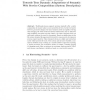31 search results - page 6 / 7 » Using symbolic descriptions to explain similarity on CBR |
104
click to vote
ATAL
2003
Springer
15 years 4 months ago
2003
Springer
This paper describes the implementation and evaluation of a framework for modeling emotions in complex, decision-making agents. Sponsored by U.S. Army Research Institute (ARI), th...
116
click to vote
ICCV
1995
IEEE
15 years 3 months ago
1995
IEEE
A new approach to tracking weakly modeled objects in a semantically rich domain is presented. We define a closed-world as a space-time region of an image sequence in which the co...
AAAI
1993
15 years 28 days ago
1993
In planning tasks an agent may often find himself in a situation demanding that he choose an action that would prevent some unwanted event from occurring. Similarly, in tasks invo...
97
Voted
HRI
2006
ACM
15 years 5 months ago
2006
ACM
The essence of the signal-to-symbol problem consists of associating a symbolic description of an object (e.g., a chair) to a signal (e.g., an image) that captures the real object....
107
click to vote
ESWS
2007
Springer
15 years 5 months ago
2007
Springer
Traditional process support systems typically offer a static composition of atomic tasks to more powerful services. In the real world, however, processes change over time: busines...

